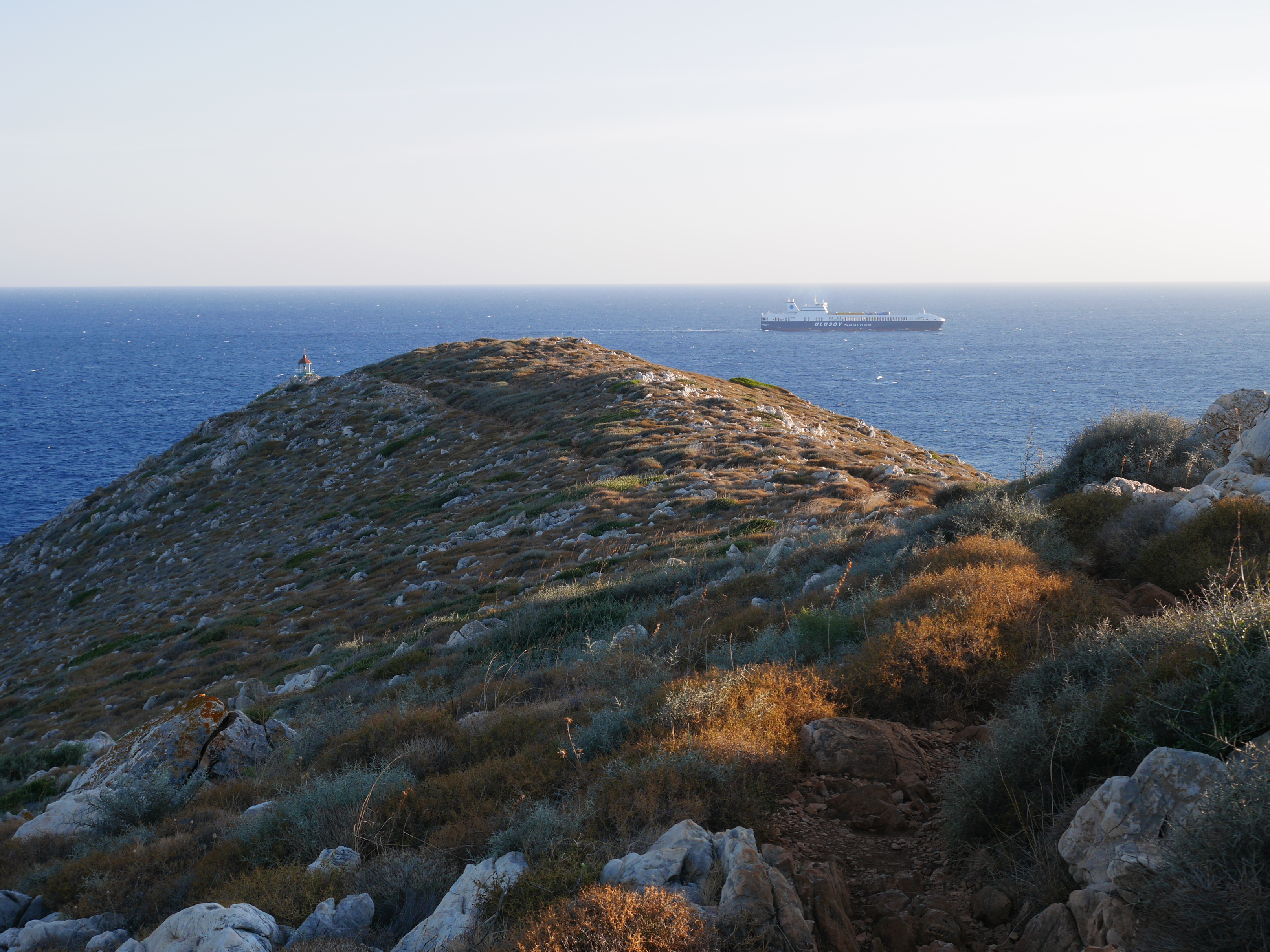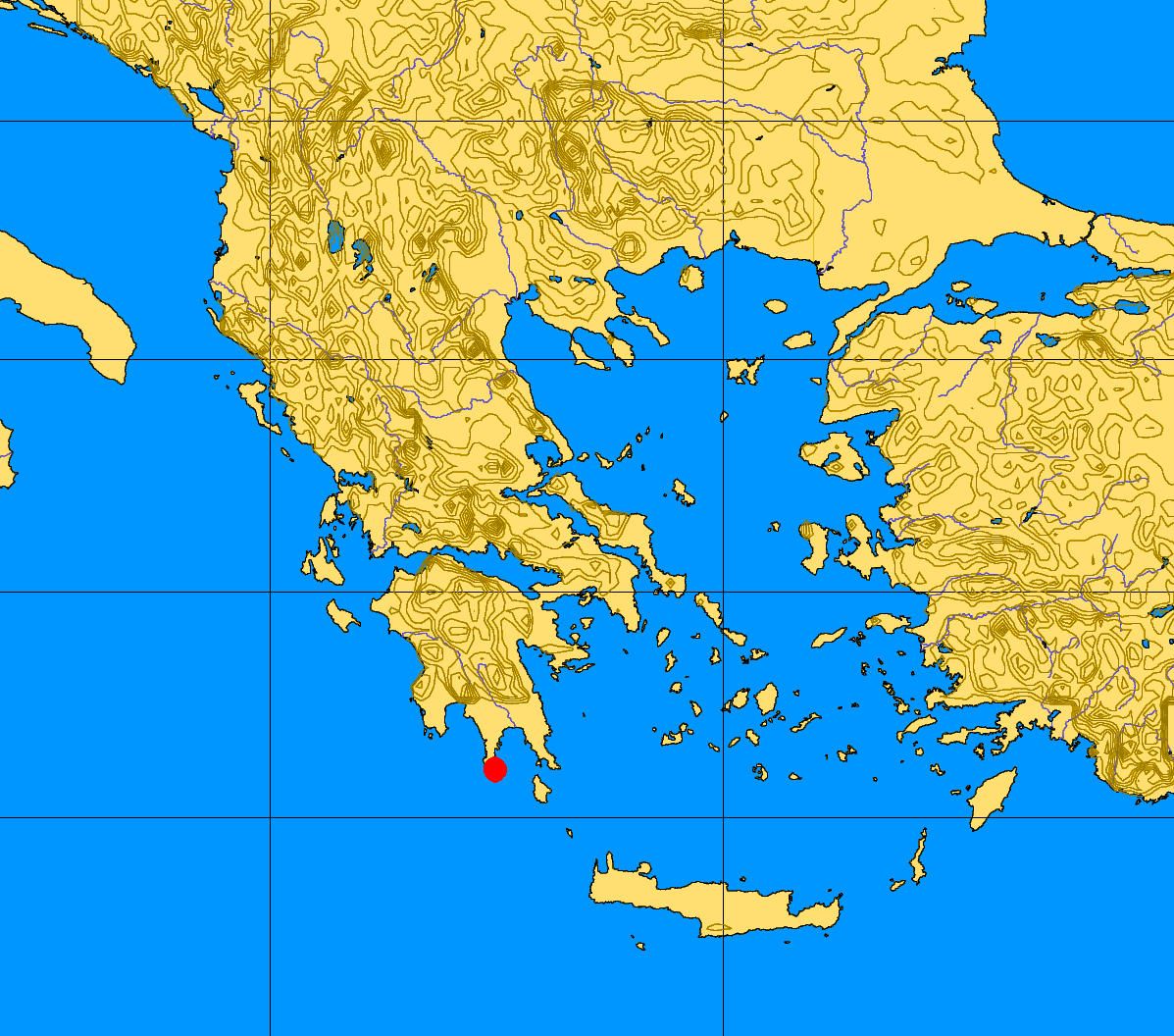Cape Matapan on:
[Wikipedia]
[Google]
[Amazon]

 Cape Matapan ( el, Κάβο Ματαπάς,
Cape Matapan ( el, Κάβο Ματαπάς, Suda,tau, 206
/ref>
Images of Cape Matapan
{{Authority control Matapan Landforms of Laconia Mani Peninsula Landforms of Peloponnese (region) Locations in Greek mythology
Maniot
The Maniots or Maniates ( el, Μανιάτες) are the inhabitants of Mani Peninsula, located in western Laconia and eastern Messenia, in the southern Peloponnese, Greece. They were also formerly known as Mainotes and the peninsula as ''Maina''. ...
dialect: Ματαπά), also named as Cape Tainaron or Taenarum ( el, Ακρωτήριον Ταίναρον), or Cape Tenaro, is situated at the end of the Mani Peninsula, Greece
Greece,, or , romanized: ', officially the Hellenic Republic, is a country in Southeast Europe. It is situated on the southern tip of the Balkans, and is located at the crossroads of Europe, Asia, and Africa. Greece shares land borders ...
. Cape Matapan is the southernmost point of mainland Greece, and the second southernmost point in mainland Europe. It separates the Messenian Gulf
The Messenian Gulf (, ''Messiniakós Kólpos'') is a sea that is part of the Ionian Sea. The gulf is circumscribed by the southern coasts of Messenia and the southwestern coast of the Mani peninsula in Laconia. Its bounds are Venetiko Islan ...
in the west from the Laconian Gulf The Laconian Gulf ( el, Λακωνικός Κόλπος, translit=Lakonikos Kolpos), is a gulf in the south-eastern Peloponnese, in Greece. It is the southernmost gulf in Greece and the largest in the Peloponnese.
In the shape of an inverted "U ...
in the east.
Cape Taenarum in classical antiquity
Classical antiquity (also the classical era, classical period or classical age) is the period of cultural history between the 8th century BC and the 5th century AD centred on the Mediterranean Sea, comprising the interlocking civilizations of ...
was the site of the city of Taenarum, (Ancient Greek
Ancient Greek includes the forms of the Greek language used in ancient Greece and the ancient world from around 1500 BC to 300 BC. It is often roughly divided into the following periods: Mycenaean Greek (), Dark Ages (), the Archaic p ...
: Ταίναρον) now in ruins. In ancient Greek mythology the eponymous ''ctistes'' — the founder-hero of the city — was Taenarus, (Ταίναρος) who was credited with establishing the city's important temple of Poseidon.
Greeks used the proverb Tainarian evil ( grc, Ταινάριον κακόν), meaning a great and unlawful evil affecting suppliants, for the Spartans
Sparta ( Doric Greek: Σπάρτα, ''Spártā''; Attic Greek: Σπάρτη, ''Spártē'') was a prominent city-state in Laconia, in ancient Greece. In antiquity, the city-state was known as Lacedaemon (, ), while the name Sparta referr ...
killed the Helots
The helots (; el, εἵλωτες, ''heílotes'') were a subjugated population that constituted a majority of the population of Laconia and Messenia – the territories ruled by Sparta. There has been controversy since antiquity as to their e ...
who had fled into Tainaron and were suppliants in the temple of Poseidon./ref>
History
Cape Matapan has been an important place for thousands of years. Near Taenarum, there is a cave thatGreek
Greek may refer to:
Greece
Anything of, from, or related to Greece, a country in Southern Europe:
*Greeks, an ethnic group.
*Greek language, a branch of the Indo-European language family.
**Proto-Greek language, the assumed last common ancestor ...
legends claimed was the home of Hades, the god of the dead. The ancient Sparta
Sparta ( Doric Greek: Σπάρτα, ''Spártā''; Attic Greek: Σπάρτη, ''Spártē'') was a prominent city-state in Laconia, in ancient Greece. In antiquity, the city-state was known as Lacedaemon (, ), while the name Sparta referre ...
ns built several temple
A temple (from the Latin ) is a building reserved for spiritual rituals and activities such as prayer and sacrifice. Religions which erect temples include Christianity (whose temples are typically called churches), Hinduism (whose temples ...
s there, dedicated to various gods. On the hill situated above the cave, lie the remnants of an ancient temple dedicated to the sea god Poseidon
Poseidon (; grc-gre, Ποσειδῶν) was one of the Twelve Olympians in ancient Greek religion and myth, god of the sea, storms, earthquakes and horses.Burkert 1985pp. 136–139 In pre-Olympian Bronze Age Greece, he was venerated as a ...
(Νεκρομαντεῖον Ποσειδῶνος). Under the Byzantine Empire
The Byzantine Empire, also referred to as the Eastern Roman Empire or Byzantium, was the continuation of the Roman Empire primarily in its eastern provinces during Late Antiquity and the Middle Ages, when its capital city was Constantinopl ...
, the temple was converted into a Christian church, and Christian rites are conducted there to this day. Cape Matapan was once the place where mercenaries waited to be employed.
A naval battle occurred there on 19 July 1717, between the Venetian navy of the Republic of Venice
The Republic of Venice ( vec, Repùblega de Venèsia) or Venetian Republic ( vec, Repùblega Vèneta, links=no), traditionally known as La Serenissima ( en, Most Serene Republic of Venice, italics=yes; vec, Serenìsima Repùblega de Venèsia, ...
, supported by a mixed squadron of allied ships from Portugal
Portugal, officially the Portuguese Republic ( pt, República Portuguesa, links=yes ), is a country whose mainland is located on the Iberian Peninsula of Southwestern Europe, and whose territory also includes the Atlantic archipelagos of ...
, the Papal States
The Papal States ( ; it, Stato Pontificio, ), officially the State of the Church ( it, Stato della Chiesa, ; la, Status Ecclesiasticus;), were a series of territories in the Italian Peninsula under the direct sovereign rule of the pope fro ...
and Malta
Malta ( , , ), officially the Republic of Malta ( mt, Repubblika ta' Malta ), is an island country in the Mediterranean Sea. It consists of an archipelago, between Italy and Libya, and is often considered a part of Southern Europe. It lies ...
, and the Ottoman fleet, under Kapudan Pasha
The Kapudan Pasha ( ota, قپودان پاشا, modern Turkish: ), was the Grand Admiral of the navy of the Ottoman Empire. He was also known as the ( ota, قپودان دریا, links=no, modern: , "Captain of the Sea"). Typically, he was bas ...
Eğribozlu İbrahim Pasha. It is known as the Battle of Matapan
The Battle of Matapan took place on 19 July 1717 off the Cape Matapan, on the coast of the Mani Peninsula, now in southern Greece. The naval battle was between the Venetian navy, Armada Grossa of the Republic of Venice, supported by a mixed sq ...
and its results were indecisive.
At Cape Matapan, the ''Titanic'''s would-be rescue ship, the SS ''Californian'', was torpedoed and sunk by German
German(s) may refer to:
* Germany (of or related to)
** Germania (historical use)
* Germans, citizens of Germany, people of German ancestry, or native speakers of the German language
** For citizens of Germany, see also German nationality law
**Ge ...
forces on 9 November 1915. In March 1941, a major naval battle, the Battle of Cape Matapan
The Battle of Cape Matapan ( el, Ναυμαχία του Ταινάρου) was a naval battle during the Second World War between the Allies, represented by the navies of the United Kingdom and Australia, and the Royal Italian navy, from 27 t ...
, occurred off the coast of Cape Matapan, between the Royal Navy
The Royal Navy (RN) is the United Kingdom's naval warfare force. Although warships were used by English and Scottish kings from the early medieval period, the first major maritime engagements were fought in the Hundred Years' War against ...
and the Italian Regia Marina
The ''Regia Marina'' (; ) was the navy of the Kingdom of Italy (''Regno d'Italia'') from 1861 to 1946. In 1946, with the birth of the Italian Republic (''Repubblica Italiana''), the ''Regia Marina'' changed its name to ''Marina Militare'' ("M ...
, in which the British emerged victorious in a one-sided encounter. The encounter's main result was to drastically reduce future Italian naval activity in the Eastern Mediterranean.
General Info
More recently a lighthouse was constructed, but it is now in disuse. As the second southernmost point of mainland Europe, the cape is on the migration route of birds headed to Africa.See also
* Taenarus (mythology) * Alepotrypa cave *Battle of Matapan
The Battle of Matapan took place on 19 July 1717 off the Cape Matapan, on the coast of the Mani Peninsula, now in southern Greece. The naval battle was between the Venetian navy, Armada Grossa of the Republic of Venice, supported by a mixed sq ...
*Battle of Cape Matapan
The Battle of Cape Matapan ( el, Ναυμαχία του Ταινάρου) was a naval battle during the Second World War between the Allies, represented by the navies of the United Kingdom and Australia, and the Royal Italian navy, from 27 t ...
References
External links
Images of Cape Matapan
{{Authority control Matapan Landforms of Laconia Mani Peninsula Landforms of Peloponnese (region) Locations in Greek mythology